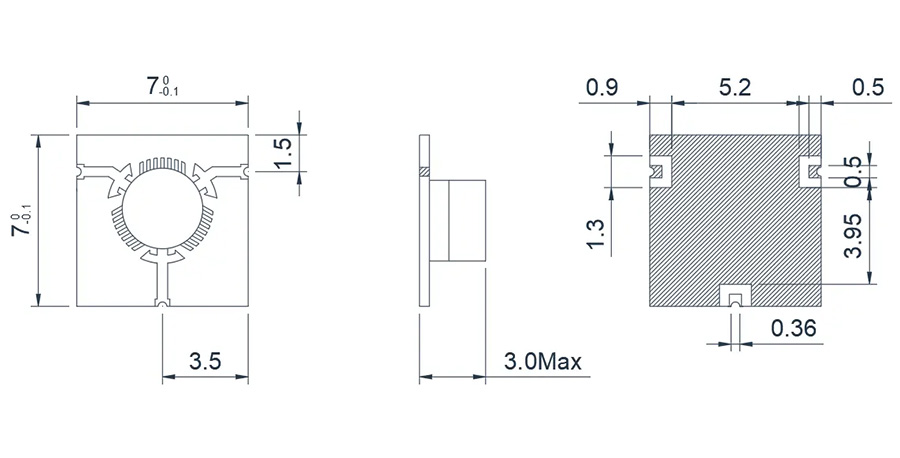- About us
- Product
- Dual-Junction Circulator
-

Dual-junction Microstrip Circulator
-

Dual-junction Drop-in Circulator
-

Dual-junction Coaxial Circulator
- Customized
- Technical Note
- News
- Contact us
NEWS
Updated on:
Keywords: SMT RF circulator, SMT RF isolator, SMT circulator, SMT isolator, SMD RF circulator, SMD RF isolator, surface-mount RF circulator, surface-mount RF isolator, SMT microwave circulator, SMT microwave isolator

Why SMT RF circulators and SMT RF isolators are becoming the default choice for compact, high-density RF and microwave systems.
In modern RF and microwave design, every millimeter of PCB area matters. As radios move into smaller enclosures and power levels keep climbing, engineers are turning to SMT RF circulators and SMT RF isolators to replace traditional bolt-down or connectorized components.
This article explains the main advantages of surface-mount RF circulators and surface-mount RF isolators, and shows why SMT circulator/isolator solutions are now a key building block in next-generation RF front-ends, phased-array radar, and 5G/6G infrastructure.
An SMT RF circulator or SMT RF isolator is a ferrite-based, non-reciprocal passive device designed specifically for surface-mount technology. Instead of using screws, waveguide flanges, or coaxial connectors, the device is soldered directly onto PCB pads through a standard SMD reflow process.
Functionally, the behavior is the same as larger RF circulators and isolators: a circulator routes RF power directionally between three ports, while an isolator protects sensitive circuitry by absorbing reflected power. The difference is the form factor: SMT versions are miniaturized, low-profile, and optimized for automated assembly.
The most visible advantage of a SMT RF circulator/isolator is its tiny size. Modern SMD ferrite designs can fit into packages comparable to other RF front-end components, shrinking from palm-sized metal blocks down to pebble-sized layouts on the PCB.
Miniaturization of SMT circulators and SMT isolators enables:
For designers fighting strict volume and weight budgets, the miniature SMT RF circulator/isolator package is often the only realistic way to integrate non-reciprocal protection without enlarging the entire system.
A second major benefit of SMT RF circulators and SMT RF isolators is the pure SMT assembly flow. The devices are mounted onto standard copper pads and soldered during reflow just like other SMD components.
Compared with drop-in or coaxial types, a surface-mount RF circulator/isolator offers:
For high-volume production, this means fewer manual operations, less variability, and lower assembly cost. A correctly designed footprint gives the SMT circulator/isolator a robust mechanical anchor and a clean RF transition at the same time.
.jpg)
Despite their compact size, high-quality SMT RF circulators and SMT RF isolators can deliver performance comparable to larger microstrip or coaxial solutions at the same frequency band.
Typical targets for a well-designed SMT RF circulator/isolator include:
In many X-band, C-band, and L-band designs, a surface-mount RF circulator or surface-mount RF isolator becomes the default choice for compact front-ends, because it balances performance, size, and manufacturability better than legacy housings.
When a SMT RF isolator is used to protect a high-power amplifier, reliability is critical. The soldered connection between the SMT package and the PCB offers:
By combining a solid thermal design and proper PCB copper areas, SMT RF circulators and isolators can dissipate heat efficiently while maintaining ferrite stability and magnet bias conditions. This results in consistent insertion loss, isolation, and phase behavior across the full operating temperature range.
From a business perspective, one of the strongest arguments for SMT circulator/isolator solutions is the total cost of ownership. Even when the device itself is a high-performance ferrite component, surface-mount integration can significantly reduce overall system cost.
Key advantages include:
For OEMs and ODMs building thousands of RF channels, replacing legacy bolt-down units with SMT RF circulators and SMT RF isolators can unlock a meaningful reduction in assembly time and line-level variability.
Because SMD RF circulators and SMD RF isolators combine small size and solid performance, they are widely used in:
In each of these cases, a compact surface-mount RF circulator/isolator removes the need for bulky mechanical housings while still providing non-reciprocal protection and isolation where it matters most.
Drop-in, microstrip, and coaxial RF circulators/isolators are still widely used, especially at very high power levels or in legacy platforms. However, for many new designs, SMT RF circulator/isolator technology provides a more attractive trade-off.
In summary:
For high-volume, small-form-factor products, the SMT approach often becomes the default choice, especially when combined with modern high-power ferrite and low-loss PCB stack-ups.
The main advantage is the surface-mount form factor. An SMT RF circulator or SMT RF isolator solders directly to the PCB, enabling automated assembly, reduced footprint, and shorter RF routing compared with bolt-down or connectorized devices.
Use an SMT RF isolator when you only need one-way protection, typically between a power amplifier and the antenna or filter. Choose an SMT RF circulator when you must route power between multiple ports, such as PA → Antenna → LNA in a compact duplexing or T/R module topology.
Yes, many surface-mount RF circulators and isolators are designed for substantial CW and peak power levels, provided that PCB layout, heat-spreading copper, and cooling are engineered correctly. Always compare the device's specified power rating with your system's worst-case VSWR and duty cycle.
They require careful footprint and stack-up design, but they actually simplify the overall layout by removing coaxial connectors and mechanical fasteners. With controlled-impedance traces, proper grounding, and thermal vias, an SMT RF circulator/isolator integrates cleanly into modern RF PCBs.
Looking for SMT RF circulator/isolator options for your next design?
Share your target frequency band, power level, and footprint constraints with our RF team. We can help match a suitable SMT RF circulator or SMT RF isolator solution and support custom development for demanding applications.
Contact: [email protected]
About the Author
HzBeat Editorial Content Team
Sara is a Brand Specialist at Hzbeat, focusing on RF & microwave industry communications. She transforms complex technologies into accessible insights, helping global readers understand the value of circulators, isolators, and other key components.